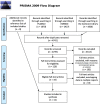Impact of dispatcher-assisted cardiopulmonary resuscitation on neurologically intact survival in out-of-hospital cardiac arrest: a systematic review
- PMID: 34030706
- PMCID: PMC8147398
- DOI: 10.1186/s13049-021-00875-5
Impact of dispatcher-assisted cardiopulmonary resuscitation on neurologically intact survival in out-of-hospital cardiac arrest: a systematic review
Abstract
Background: Dispatcher-assisted cardiopulmonary resuscitation (DA-CPR) increases neurologically intact survival in out-of-hospital cardiac arrest (OHCA) according to several studies. This systematic review summarizes neurologically intact survival outcomes of DA-CPR in comparison with bystander-initiated CPR and no bystander CPR in OHCA.
Methods: The systematic review was conducted according to the PRISMA guidelines. All studies including adult and/or pediatric OHCAs that compared DA-CPR with bystander-initiated CPR or no bystander CPR were included. Primary outcome was neurologically intact survival at discharge, one-month or longer. Studies were searched for in PubMed (MEDLINE), EMBASE, and the Cochrane Library databases. The risk of bias was evaluated using the Newcastle-Ottawa Scale.
Results: The search string generated 4742 citations of which 33 studies were eligible for inclusion. Due to overlapping study populations, the review included 14 studies. All studies were observational. The study populations were heterogeneous and included adult, pediatric and mixed populations. Some studies reported only witnessed cardiac arrests, arrests of cardiac ethiology, and/or shockable rhythm. The individual studies scored between six and nine on the Newcastle-Ottawa Scale of risk of bias. The median neurologically intact survival at hospital discharge with DA-CPR was 7.0% (interquartile range (IQR): 5.1-10.8%), with bystander-initiated CPR 7.5% (IQR: 6.6-10.2%), and with no bystander CPR 4.4% (IQR: 2.0-9.0%) (four studies). At one-month neurologically intact survival with DA-CPR was 3.1% (IQR: 1.6-3.4%), with bystander-initiated CPR 5.7% (IQR: 5.0-6.0%), and with no bystander CPR 2.5% (IQR: 2.1-2.6%) (three studies).
Conclusion: Both DA-CPR and bystander-initiated CPR increase neurologically intact survival compared with no bystander CPR. However, DA-CPR demonstrates inferior outcomes compared with bystander-initiated CPR. Early CPR is crucial, thus in cases where bystanders have not initiated CPR, DA-CPR provides an opportunity to improve neurologically intact survival following OHCA. Variability in OHCA outcomes across studies and multiple confounding factors were identified.
Keywords: Cardiac arrest; Cardiopulmonary resuscitation; DA-CPR; Dispatcher-assisted CPR; Emergency medical services; Medical dispatch; Out-of-hospital cardiac arrest; Systematic review; T-CPR; Telephone-assisted CPR.
Conflict of interest statement
The authors declare that they have no competing interests.
Figures




References
-
- World Health Organization. The top 10 causes of death. 2018. http://www.who.int/news-room/fact-sheets/detail/the-top-10-causes-of-death: [Accessed 10 Nov 2020].
Publication types
MeSH terms
LinkOut - more resources
Full Text Sources
Other Literature Sources
Medical

